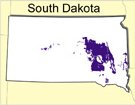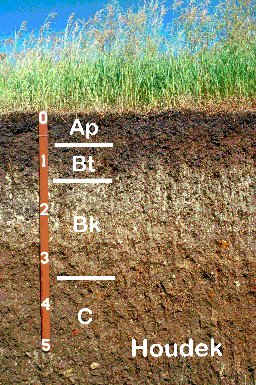
HOUDEK LOAM
THE STATE SOIL of SOUTH DAKOTA
STATE SOIL
What do the Chinese ring-necked pheasant, the Black Hills spruce, the pasque, rose quartz, triceratops, and the Houdek loam have in common? They are all state symbols. The Chinese ring-necked pheasant is the state bird, the Black Hills spruce is the state tree, the pasque is the state flower, rose quartz is the state mineral, triceratops is the state fossil, and Houdek loam is the state soil.
What is the Houdek loam? How extensive is this soil? Why was Houdek loam selected as South Dakota�s (SD) state soil? What is the importance of agriculture to the state? How many different soils are recognized in SD? These and other questions are answered below.
COMMEMORATION
South Dakota has a large acreage of productive, prairie derived soils on glacial till plain landforms. Most of these soils are medium textured and have high natural fertility. Houdek is a native soil of SD and does not occur in any other state. The Houdek soil was chosen because of its large extent and its importance to agriculture. There are more than 2 million acres of Houdek and closely related soils. It is one of the most extensive soils in the state.
Location of Houdek soils in South Dakota

Houdek soils are used extensively for cropland, hayland, and rangeland. Small grains, corn, sunflowers, and soybeans are commonly grown crops. Alfalfa and alfalfa-grass mixtures provide hay and pasture for grazing livestock. Large areas of Houdek soils are in native range. Crops and grasses grown on the Houdek soil provide habitat to wildlife.
The Professional Soil Scientists Association of SD and the SD Chapter of the Soil and Water Conservation Society worked together to commemorate the importance of soil to SD. It is fitting that Houdek loam, a typical prairie derived glacial till soil, was adopted as the state soil to acknowledge the importance soil has played in our State�s most important industry, agriculture.
In 1990, the late Governor George Mickelson signed a House Bill into law, making the Houdek loam South Dakota�s Official State Soil. The technical (taxonomic) classification of the Houdek soil is fine-loamy, mixed, superactive, mesic Typic Argiustolls.
HOUDEK SERIES
The Houdek series was established in 1955 in Spink County, South Dakota. The series was separated from the Barnes series which was established in 1914.
 |
The
Houdek topsoil formed from the weathering of glacial till and
the decomposition of grass residues causing the deep dark
colored topsoil with 2-4 % organic matter. The subsoil of the
Houdek soil is divided into two parts: 1) a layer of clay
accumulation; and 2) a layer of lime accumulation. As the Houdek
soils weathered and formed, water from the soil surface carried
lime and clay downward. These materials were deposited deeper,
forming the two subsoil layers. The last layer in the Houdek
soil is the parent material. This layer represents the materials
from which the Houdek soil has developed with time. It
represents what the glacier originally left at the soil surface.
Climate factors and vegetation/soil organisms have weathered the
glacial parent materials to form the present day Houdek soil. The typical Houdek soil profile includes: a 6-8 inch friable, neutral, black loam topsoil; a 10 to 15 inch friable, neutral, dark brown clay loam subsoil; a 15 to 30 inch friable, calcareous, moderately alkaline, olive brown clay loam subsoil; and 20+ inches of friable, light olive brown, calcareous, moderately alkaline clay loam parent material. |
Soils of the Houdek series are very deep (>60 inches to bedrock), well drained and formed in glacial till (a mixture of boulders to clay) on stable uplands. The slopes can range from 0 to 25 % with most Houdek soils having a slope of 0 to 6%. The mean annual precipitation is 22 inches and the average annual temperature is 47 OF. Houdek soils formed under prairie vegetation (mid-grass) in a subhumid climate.
Houdek soils have moderate amounts of organic matter, extractable nutrients, clay, silt, sand, cation exchange capacity (ability to hold nutrients), and a high plant available water holding capacity.
Other soils in SD differ from the Houdek soil because they have different characteristics and properties, much like a collie dog is different from other breeds of dogs. Soils that are found east of the Houdek series tend to have higher organic matter levels, are more moist, and are used more intensively for row crop production. Soils that are found west of the Houdek series tend to be drier and have formed in different parent materials (west of the Missouri River bedrock predominates) and are used for small grain and range production. Some soils are underlain by gravel and others are poorly drained.
Because soils are complex, variable, and occur as a mosaic on the land, it is difficult for one to learn them all. However, if one learns the properties of the state soil, Houdek, then other soils can be compared to it.
IMPORTANCE OF SOILS
Soils are not an unlimited natural resource. Soils take thousands of years to form and it only takes a few years to destroy their productivity as a result of erosion and other types of improper management. Soils are used to produce crops, range, timber, and for recreation. They are used for engineering purposes and are an integral part of the water cycle. Soils are nature�s waste disposal medium and they serve as habitats for many varied kinds of plants, birds, animals, and microorganisms. Soils are basic to our survival. We can not live without them. Socially, economically, and environmentally soils are crucial to society�s growth and development.
"Out of all the long list of nature�s gifts to humans, none is perhaps so utterly essential to human life as soil" H.H. Bennett
SOUTH DAKOTA SOIL SERIES
Soils may be thick to thin, stony to not stony; saline to not saline; sandy, silty, loamy, or clayey; sloping, flat, or in depressions; and may occur where climates are moist to dry and warm to cool.
The unique combinations of soil forming factors has led to the discovery in South Dakota of more than 550 different kinds of soils called "soil series." Each soil series is uniquely defined by the different colors, organic matter levels, textures, layers or horizons, parent materials, and other morphological, chemical, and physical properties.
SOIL FORMING FACTORS
The kind of soil that develops in any area is the result of the interaction of the five soil forming factors; climate, biota (vegetation and soil organisms), parent material, topography, and time or the age of the soil.
Climate controls the distribution of vegetation/soil organisms. Together climate and vegetation/soil organisms often are called the "active factors" of soil formation (genesis). This is because on gently undulating topography within a certain climatic and vegetative zone a characteristic or typical soil will develop unless parent material differences are very great. Thus, the tall and mid-grass prairie soils have developed across a variety of parent materials.
The factor of parent material exerts its influence on soils principally by determining their texture and to a great extent their mineralogical composition.
The factor of topography (relief or landscape position) exerts its greatest influence by determining what drainage class a soil will have. Steep slopes have excessively drained, thin soils and flat or depressed topographic areas usually have poorly drained, thick soils. The mature, typical (normal), well-drained grassland soils develop on undulating relief where climate and vegetation are given full expression.
The factor of time (age of soil stability) can be illustrated by comparing a soil on a flood plain which receives annual increments of alluvium with a soil on a upland. The young floodplain soil has no developed genetic horizons, although it may have strata of contrasting alluvium, while the upland soil will usually have a soil profile with many developed horizons.
AGRICULTURE�S IMPORTANCE TO SOUTH DAKOTA
When a state depends heavily upon agriculture for its livelihood, soil stewardship becomes an especially important matter. Stewardship of the land depends upon one�s knowledge of soil characteristics and qualities.
South Dakota is an agricultural state with an area of 77, 047 square miles and a population density of nine persons per square mile. Cash receipts from farming and ranching normally exceeds $3 billion each year.
On the average, SD ranks nationally in the top ten for corn, soybeans, spring wheat, oat, alfalfa hay, all hay, grain sorghum, sunflower seed, barley, rye, and flaxseed production.
These crops and their products, along with forage, range, and pasture grown in the state, provide feed for large numbers of livestock. On the average, SD ranks nationally in the top ten for beef, sheep, hog, and honey production.
This production is possible because SD has large areas of productive soils. One of these productive soils is the Houdek loam, our state soil. Soils are the foundation of life and the economic base for SD. They have properties and characteristics which influence their suitabilities for various uses. It is critical for society to understand how soils form and develop. Soil is worth protecting. Houdek loam is a symbol which one can use to help increase public awareness of South Dakota�s soil resources.
FOR FURTHER INFORMATION AND READING
Persons interested in learning more about soils and/or the specific soils of a county or area should contact the United States Department of Agriculture (Natural Resources Conservation Service), South Dakota State University (Agricultural Experiment Station or the Cooperative Extension Service), or the South Dakota Department of Agriculture.
Many counties in South Dakota have published, modern detailed soil survey reports. These soil survey reports are available at the local (county) USDA-Natural Resources Conservation Service or the SDSU Cooperative Extension Service offices.
NRCS - Brochure on
the Houdek Soil
- ![]() PDF format
PDF format
Related Sites
This document was prepared and published by the Professional Soil Scientists Association of South Dakota and the South Dakota Chapter of the Soil and Water Conservation Society. These non-profit organizations are dedicated to the wise use and conservation of South Dakota�s soil and water resources.
DDM/JJD/TES - 6/97; revised 7/99; 9/99;
3/01; 12/02; 2/20

